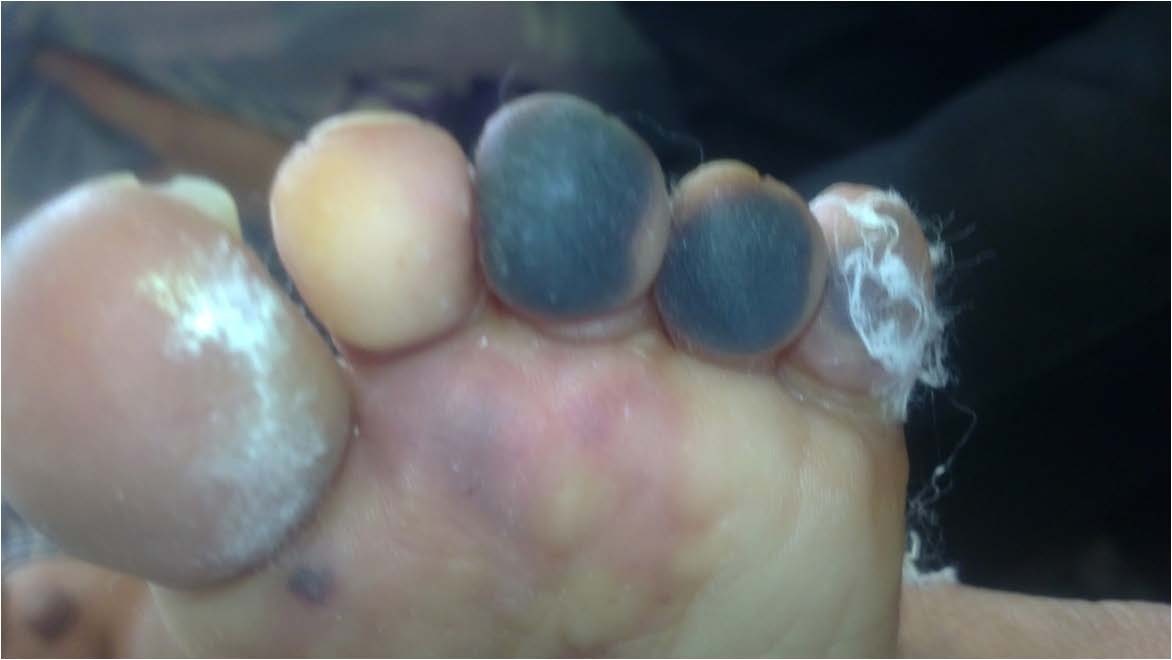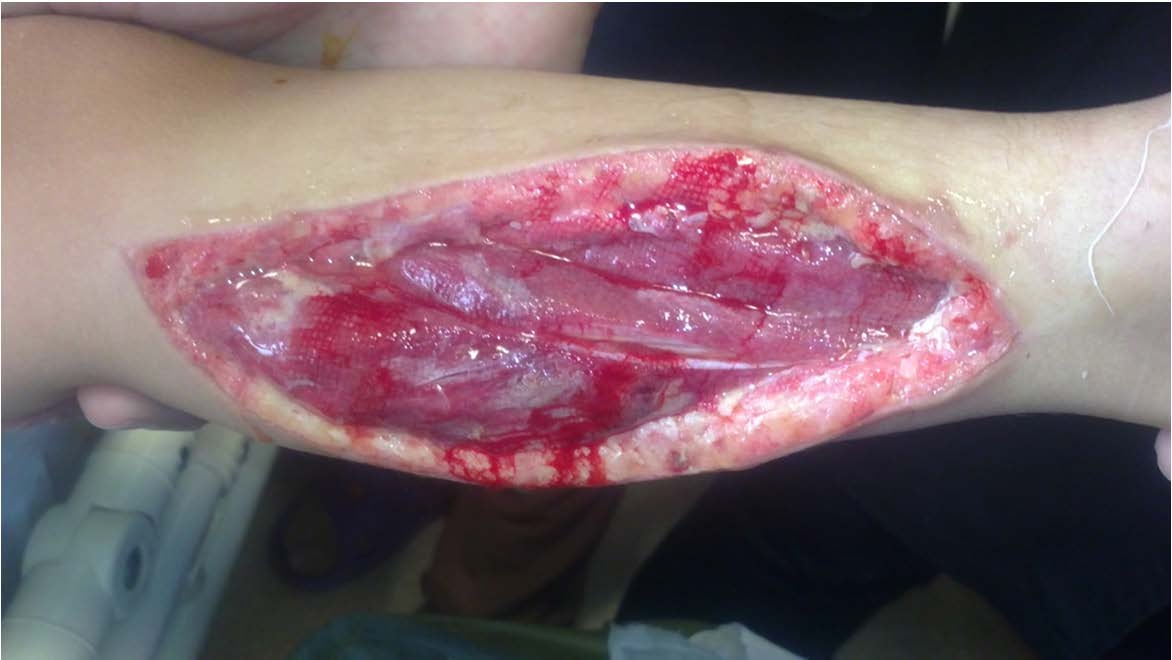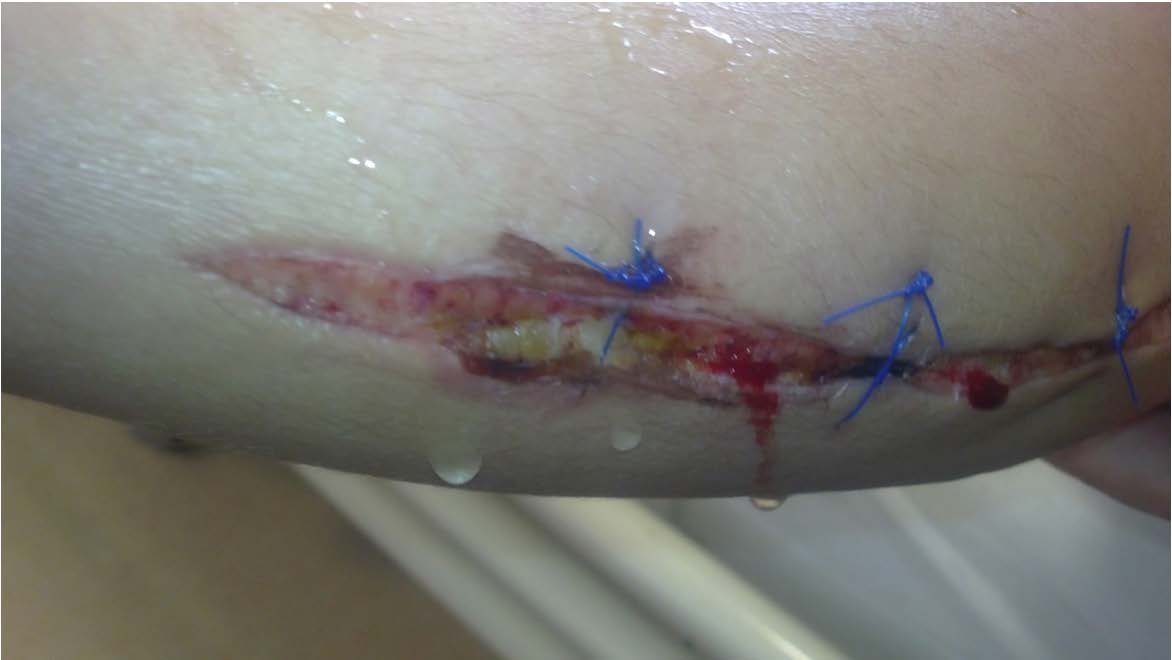Claudication Due to Sciatic Nerve Palsy Following Nicolau Syndrome: A Case Report
Masoud Hatefi1, Nabi Ramezani Pirabadi2, Javaher Khajavikhan3, Molouk Jaafarpour4
1 Neurosurgeon, Department of Neurosurgery, Medicine Faculty, Ilam University of Medical Science, Ilam, IR-Iran.
2 Orthopaedist, Department of Orthopaedics, Medicine Faculty, Ilam University of Medical Science, Ilam, IR-Iran.
3 Anaesthesiologist, Department of Anesthesiology, Medicine Faculty, Ilam University of Medical Science, Ilam, IR-Iran.
4 MSc of Midwifery, Department of Midwifery, Nursing & Midwifery Faculty, Ilam University of Medical Science, Ilam, IR-Iran.
NAME, ADDRESS, E-MAIL ID OF THE CORRESPONDING AUTHOR: Mrs. Molouk Jaafarpour, MSc of Midwifery, Department of Midwifery, Nursing & Midwifery Faculty, Ilam University of Medical Science, Ilam, IR-Iran.
E-mail: jaafarpourm@gmail.com
Nicolau syndrome is a rare drug reaction due to intramuscular injection administration that can lead to limb loss or even death. A 3.8-year-old Iranian boy received an intramuscular injection of Benzathine Penicillin. Immediately after injection the child developed lower limb pain and livedoid discolouration and was referred to our department. The patient was diagnosed to develop Nicolau syndrome and fasciotomy carried out due to compartment syndrome. Pharmacologic therapy with Heparin, Cefazolin and Methylprednisolone was initiated. On 18th day, he was discharged, although he was not able to move. Finally, after 6 months of care at home, physiotherapy and Electromyography (EMG) at regular intervals, the child was gradually able to move and his claudication improved.
Case Report
A 3.8-year-old Iranian boy with upper respiratory tract infection received an intramuscular injection of Benzathine Penicillin on the upper outer quadrant of the left buttock at an outpatient clinic in Oct 2014. Immediately after the injection child developed in severe pain, swelling, cyanosis of toes [Table/Fig-1] and livedoid patch on the lower abdomen and left lower limb. He was referred to paediatric department in our hospital 6 hours later. On admission, initial examination and vital signs were normal and patient was not critically ill, but blood testing revealed a raised erythrocyte sedimentation rate (ESR: 24) and glucose (GLU: 170). The popliteal, dorsiflexion, plantar flexion, dorsalis pedis, posterior tibial pulses and sciatic were not detected. Doppler sonography carried out for the left lower limb and Computed Tomography (CT)–Angiography was done to examine blood vessels and it was normal.

Fasciotomy of the calf (Bilateral) was carried out on the second day due to compartment syndrome to prevent irreversible ischemia [Table/Fig-2,3]. The compartment syndrome was confirmed according to clinical findings including ischemic limb, tense oedema and passive extension of ankle. Pharmacologic interventions included intravenous Heparin (1000 U/Q 4h), Cefazolin (300 mg QID) and Methylprednisolone (5mg BD) were initiated. On the 18th day, after closing of patient’s wound he was discharged. At discharge time, the child was not able to move. After the discharge the child underwent physiotherapy and EMG at regular intervals. After 3 months, some of the toes that were necrotic, grow again. Finally, after 6 months of care at home, physiotherapy and Electromyography (EMG) at regular intervals, the child was gradually able to move and his claudication improved. It seems that claudication was due to direct injection in the sciatic nerve.
Internal fasciotomy of calf

External fasciotomy of calf

Discussion
Nicolau syndrome is a rare complication and drug reaction of intramuscular injection [1–4] that was first showed in 1924 by Freudenthal & Nicolau following the injection of bismuth salts for syphilis [1,3,5,6]. In literature this syndrome has been reported after intramuscular administration of a variety of drugs such as Non-Steroidal Anti-Inflammatory drugs (NSAIDs), Corticosteroids, Penicillin, Local Anaesthetics, Vitamin K, Petoprofen, Piroxicam, Meperidine, Diphtheria, Tetanus, Pertussis Vaccine, Antihistaminics, Antipsychotics and Antiepileptic [1–3,7,8]. Clinical findings included presence of pain at the injection site, oedema, livedoid patch, local erythema or haemorrhagic lesion following the injection and consequently necrosis of the skin, soft tissue and muscle [4,6–9].
Nicolau syndrome has been reported more in paediatric population [6] that involves the skin, subcutaneous and muscle tissue with possible necrosis [1]. Most patients usually improve although limb loss or even death has been reported [9]. The neurological complications such as hypoesthesia and paraplegia also have been reported [6].
In case report by Noaparast et al., [1] a 3-year-old boy after intramuscular injection of benzathine penicillin, ten days after fasciotomy, patient’s wound was closed and gradually improved but in our case report, due to sciatic nerve paralysis the child was suffering from limping and after 6 months of care gradually improved. According to previous studies subcutaneous and intramuscularly injection of drug, is a risk factor for Nicolau syndrome [1].
The pathogenesis of the disease is not well understood, but several parameters contribute to Nicolau syndrome. First hypothesis is sympathetic nerve is stimulated by pain with injection of drugs and results in vasospasms and ischemia. Second hypothesis is embolism of crystals in the vascular compartment due to intramuscular, intravenous, or intraarterial injection [1,6]. Diagnosis is according to clinical findings after intramuscular injection which includes: pain, oedema and livedoid erythematous or skin discolouration [1]. There is not a standard treatment for Nicolau syndrome, but supportive treatments included, pain control, anticoagulant therapy (such as Heparin), steroids (such as Methylprednisolones), vasoactive therapy (such as Pentoxyphylin), and hyperbaric oxygen, avoidance of cold compresses (can cause vasoconstriction and deterioration of ischemia), systemic antibiotics, surgical debridement, fasciotomy if necessary, skin graft and flap reconstruction [1, 6]. According to the non-inevitability of Nicolau syndrome, in order to prevent the complication of this syndrome the following actions are necessary: A suitable long needle for injection (A 90-kg patient requires a 5 to 7.5cm (2,3 inch) needle and a 45-kg patient requires a 3.18 or 3.68cm (1.25 or 1.45inch) needle), injection in the upper outer quadrant of the buttock due to few blood vessels, the Z-track method of intramuscular injection, injection after aspiration and not inject more than 5ml at a time [1,6,7].
Conclusion
To conclude, healthcare personnel and physicians must be aware of characteristics of Nicolau syndrome, following intramuscular injection of a common drug such as, Benzathine Penicillin and avoid unnecessary injection in children. All injections should be performed in equipped medical centers and clinicians should use suitable injection methods.
[1]. Noaparast M, Mirsharifi R, Elyasinia F, Parsaei R, Kondori H, Farifteh S, Nicolau syndrome after intramuscular benzathine penicillin injection IJMS 2014 39(6):577-79. [Google Scholar]
[2]. Kim KK, Nicolau syndrome in patient following diclofenac administration: a case report Ann Dermatol 2011 23(4):501-03. [Google Scholar]
[3]. Senel E, Nicolau syndrome as an avoidable complication JFCM 2012 19(1):52-53. [Google Scholar]
[4]. Lie C, Leung F, Chow SP, Nicolau syndrome following intramuscular diclofenac administration: a case report Journal of Orthopaedic Surgery 2006 14(1):104-07. [Google Scholar]
[5]. Guarneri C, Polimeni G, Nicolau syndrome following etanercept administration Am J Clin Dermatol 2010 11(Suppl 1):51-52. [Google Scholar]
[6]. Kılıç I, Kaya F, T, Özdemir A, Demirel T, Çelik I, Nicolau syndrome due to diclofenac sodium (Voltaren) injection: a case report Journal of Medical Case Reports 2014 8:404 [Google Scholar]
[7]. Nayc S, Gurel MS, Nicolau syndrome following intramuscular diclofenac injection Indian Dermatology Online Journal 2013 4(2):152-53. [Google Scholar]
[8]. Kim SK, Kim TH, Lee KC, Nicolau Syndrome after Intramuscular Injection: 3 Cases APS 2012 39:249-52. [Google Scholar]
[9]. Okan G, Canter HI, Nicolau syndrome and perforator vessels: a new viewpoint for an old problem Cutan Ocul Toxicol 2010 29:70-72. [Google Scholar]